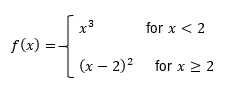Determine if the graph of the function is continuous and/or differentiable at .
Table of contents
- 0. Functions4h 53m
- 1. Limits and Continuity2h 2m
- 2. Intro to Derivatives1h 33m
- 3. Techniques of Differentiation2h 18m
- 4. Derivatives of Exponential & Logarithmic Functions1h 16m
- 5. Applications of Derivatives2h 19m
- 6. Graphical Applications of Derivatives6h 0m
- 7. Antiderivatives & Indefinite Integrals48m
- 8. Definite Integrals4h 36m
- 9. Graphical Applications of Integrals1h 43m
- 10. Integrals of Inverse, Exponential, & Logarithmic Functions21m
- 11. Techniques of Integration2h 7m
- 12. Trigonometric Functions6h 54m
- Angles29m
- Trigonometric Functions on Right Triangles1h 8m
- Solving Right Triangles23m
- Trigonometric Functions on the Unit Circle1h 19m
- Graphs of Sine & Cosine46m
- Graphs of Other Trigonometric Functions32m
- Trigonometric Identities52m
- Derivatives of Trig Functions42m
- Integrals of Basic Trig Functions28m
- Integrals of Other Trig Functions10m
- 13: Intro to Differential Equations2h 23m
- 14. Sequences & Series2h 8m
- 15. Power Series2h 19m
- 16. Probability & Calculus45m
2. Intro to Derivatives
Differentiability
Struggling with Business Calculus?
Join thousands of students who trust us to help them ace their exams!Watch the first videoMultiple Choice
Determine if the functionf(x) is continuous and/or differentiable at x=2.

A
Continuous and non-differentiable
B
Continuous and differentiable
C
Discontinuous and non-differentiable
D
Discontinuous and differentiable
 Verified step by step guidance
Verified step by step guidance1
Step 1: To determine if the function is continuous at x=2, check if the left-hand limit (as x approaches 2 from the left) equals the right-hand limit (as x approaches 2 from the right) and if both equal f(2). For x < 2, f(x) = x^3, and for x ≥ 2, f(x) = (x - 2)^2.
Step 2: Calculate the left-hand limit of f(x) as x approaches 2 from the left. Substitute x=2 into the expression x^3 to find the value of the limit.
Step 3: Calculate the right-hand limit of f(x) as x approaches 2 from the right. Substitute x=2 into the expression (x - 2)^2 to find the value of the limit.
Step 4: Compare the left-hand limit, right-hand limit, and f(2). If all three values are equal, the function is continuous at x=2. If not, the function is discontinuous at x=2.
Step 5: To determine differentiability at x=2, check if the derivative of f(x) from the left-hand side equals the derivative from the right-hand side at x=2. Compute the derivative of x^3 for x < 2 and the derivative of (x - 2)^2 for x ≥ 2, then evaluate both derivatives at x=2 and compare their values.

 5:02m
5:02mWatch next
Master Determining Differentiability Graphically with a bite sized video explanation from Patrick
Start learningRelated Videos
Related Practice
Multiple Choice
Differentiability practice set


